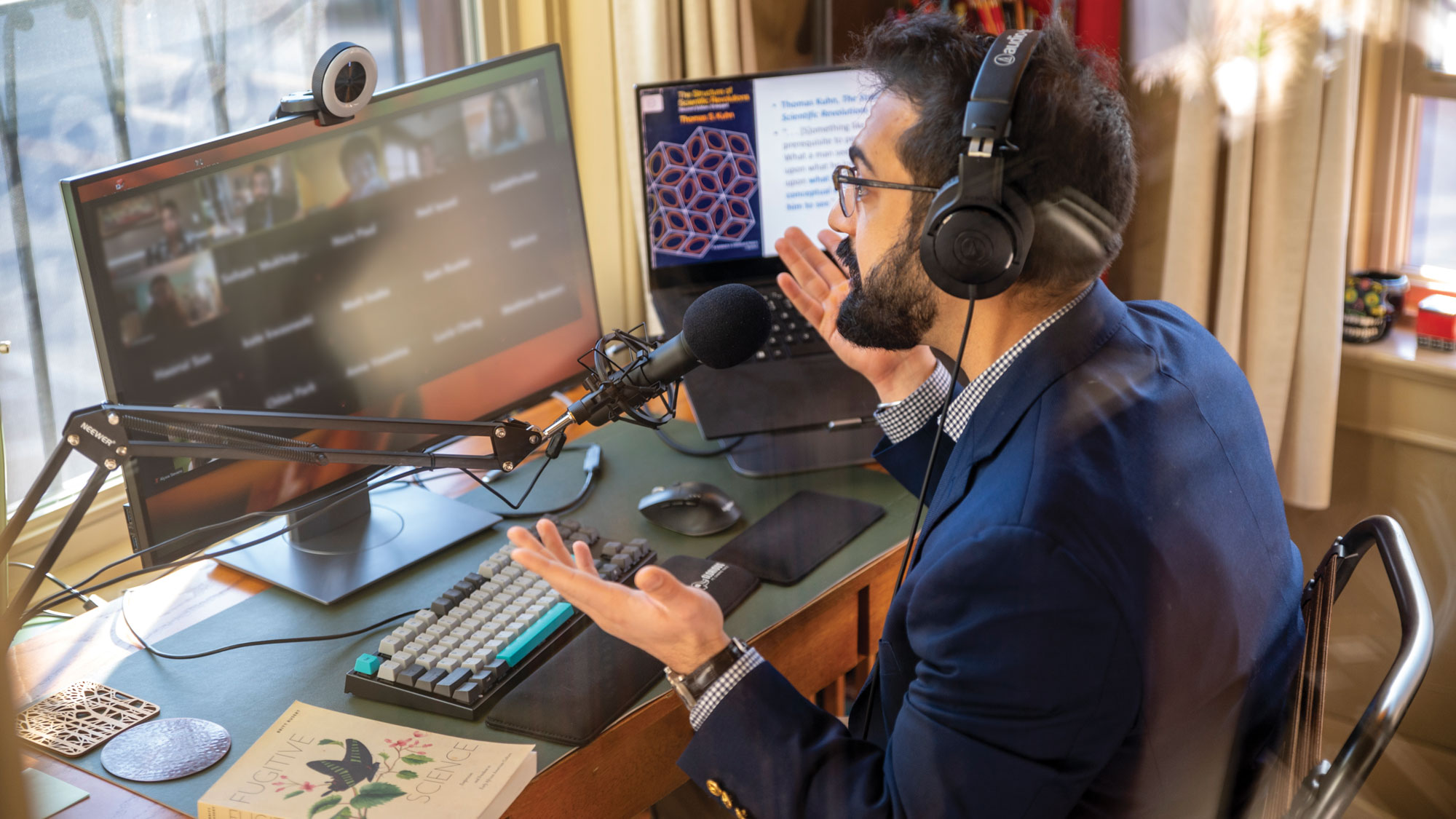Teaching Transformation
“We’re in new territory now, and we’ll make the best of it.”
This was the first conversation Matthew Kluber, professor of studio art, had with his students at the beginning of the Fall 1 term.
He was, of course, correct. In March 2020, Grinnell College took the unprecedented step of sending students home from campus and reorganizing all classes to online or remote learning formats as the COVID-19 pandemic swept across the country.
When the College made this move, its primary considerations were the safety of students, faculty, and staff, and limiting community spread of the virus. But even as students were packing their bags and leaving campus, the College also prioritized their ability to continue a Grinnell education — to have learning opportunities that encourage exploration and connect students with one another, with faculty, and with the world.
“In the first conversation I had with my class, we discussed and acknowledged that all of this was a new situation for me as well as them, and that we would get through it together,” Kluber says. “That was crucial, and the students were really on board and understanding. That made a big difference.”
Taking the leap
For many students who grew up with a computer within arm's reach, the concept of online learning was not unusual. But for many professors, whose focus on hands-on learning is part and parcel of what makes a Grinnell education unique, this was foreign territory.
“I had no prior experience teaching online other than using Blackboard (a web-based course-management system) for assignments,” says Joshua Sandquist, associate professor of biology. “I never even took a class online as a student. One of the things that makes the biology department unique is that we leverage the ‘doing’ of science early on. My first thought when the shift to online learning happened was, ‘Oh no, there goes our whole philosophy of teaching. Our program is built on learning by doing.’ But when the time came, I thought, ‘All right, this is the reality of the situation. What can I focus on to help them learn?’ And I realized you can design experiments without being in a lab, and you can analyze data even if you didn’t create it.”
The general consensus among faculty was that the situation was not ideal and posed many challenges, but it was necessary and would not prevent them from providing the best possible opportunities for students.
“I was filled with a lot of anxiety, just like our students,” says John Garrison, professor of English and program chair of peace and conflict studies. “I was worried about learning to teach online effectively and worried that what I did in the classroom could not be transferred to an online environment.
“Like a lot of faculty, I spent most of the summer trying out different tech platforms and interactive tools, thinking about how they might or might not translate to the classroom. I kind of came back to the basics of what worked really well in my in-person classes — getting students talking to each other and reading text aloud. I realized that could continue to happen without me learning a bunch of new tools.”
Making it work
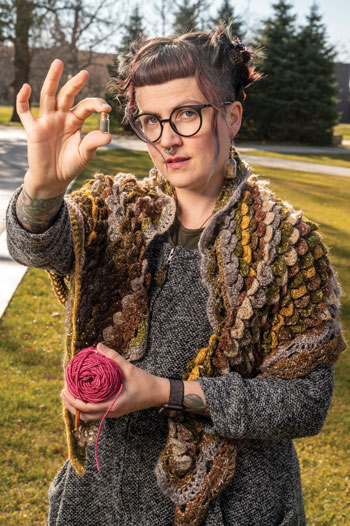 Even professors who had experience teaching online found it challenging to provide the typical hands-on Grinnell experience.
Even professors who had experience teaching online found it challenging to provide the typical hands-on Grinnell experience.
Jennifer Snook, senior lecturer in sociology, spent the decade before she arrived at Grinnell in 2015 teaching both in-person and online courses through the University of Mississippi.
For Fall 1, Snook was planning to teach a tutorial, The Art of Craft: How Crafting Informs the Social World. Her idea was to incorporate Black voices and experiences in the class, explore how people perceive art versus craft, and interrogate how those ideas are influenced by class and gender. The plan was to order yarn from a Black yarn dyer and then invite her to speak to the class in person. Students would then sit together to crochet and ultimately “yarn bomb” campus in a community-building exercise. Then word came that her class would not meet on campus.
“Well, crap,” Snook thought. “There goes my entire schtick.”
The irony of a professor with years of experience teaching online having her plans for in-person interaction thwarted by returning to her area of expertise was not lost on Snook. But the challenges were not insurmountable.
Snook ordered the yarn as planned, then divided it into individual balls for each student. She filled small glass vials with dust from central campus, put one in the middle of each yarn ball, and mailed them to students along with a crochet hook.
“I wanted to give them a piece of the earth from this place to hold onto, to help them maintain that connection to this physical place,” she says. “When they finally do get to come to campus, they will have the tools to complete the yarn bomb as planned. It was important to me that this physical aspect remain a part of the class. There’s something about engaging in the world with your body that the digital screen just can’t replace.”
Studio art at home
Other professors have used the digital world to inspire and create real-world experiences and engagement over the past year.
Matthew Kluber’s Art 111: Introduction to Studio course has always taught students the tools of the trade through hands-on studio work. Shifting this to an online format required what he described as a “radical rethinking of the class.”
His students in Fall 1 were provided a “studio packet” containing many of the materials they would normally use — pencils, sketchbooks, assorted papers for different projects, rulers, drawing instruments, glue, and wire. Although the equipment was then in hand, every student was working from a different environment and facing different challenges that had to be taken into consideration.
“It worked a lot better than I anticipated,” Kluber says. “I learned my anticipation and nervousness over teaching in this unfamiliar way was worse than the reality of it. Once we got started I realized that, while it’s not the ideal scenario, it works pretty well. It just comes back to being able to talk about what you’re passionate about, which is the same thing you do in the classroom.”
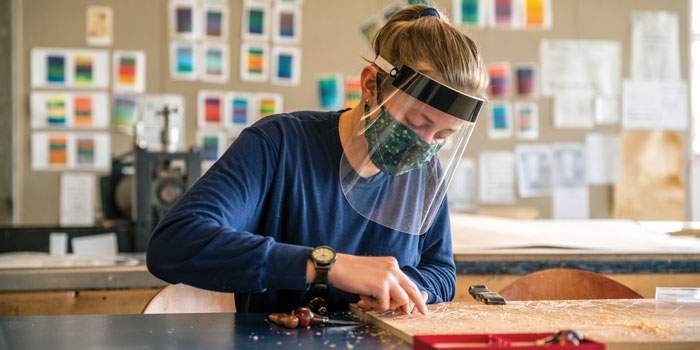
Hannah Taylor ’21 works in the printmaking studio on a project for her fall term 2 advanced studio art class.
Analog experiences in a digital world
When his classes first shifted to an online format last spring, Joshua Marshack, assistant professor of anthropology, focused heavily on the digital aspect required of the class.
“When it became obvious that we would have to shift to remote learning, I was first worried about the state of the world, and then I was concerned about how we were going to provide the same Grinnell experience virtually,” says Marshack.
Reflecting upon his initial foray into online teaching, Marshack determined he would shift his focus in future classes to using the digital realm to create analog experiences for his students.
He discovered he could do this without relying on complicated or flashy technologies. For instance, Marshack engaged Nick Lehane, a Brooklyn-based puppet artist and theater maker, to speak to his animal studies class. Lehane told a story titled “Chimpanzee” about a chimpanzee born in the wild who is raised in captivity and ends up in a laboratory. Marshack then asked the students to contemplate the last animal they had touched, how the animal experienced the world, and how it reacted to them. They then used household objects to create a simple puppet of their animal, to help them imagine the best and worst that the animal felt. Then they incorporated those feelings into the way they worked the puppet.
“It was really in their head and reflective,” Marshack says. “It’s an exercise that helped them understand other life forms on the planet and have deep empathy for them.”
Marshack, who is in his second year of teaching at Grinnell, also discovered that virtual field trips and visits with experts allowed both him and his students to develop a relationship with and an understanding of their educational home.
“Yes, we have the world at our fingertips, but it’s important to make people realize that Grinnell is special, too,” says Marshack. “I reached out to colleagues in Portugal, California, and Indiana to visit with the class, and that’s nice; but it doesn’t connect you with campus, with home, with Grinnell and all the resources available in those places.”
Marshack incorporated virtual field trips to the Grinnell College Museum of Art, the Des Moines Art Center, the Natural History Museum at the University of Iowa, the Great Ape Trust in Des Moines, and other locations into his coursework, using the vast virtual world to introduce students to opportunities in their own backyards.
“It has really helped me connect to a lot of local resources,” he says. “And it has helped students feel a connection to the place in which they live. When this is over, they might want to do research or an internship at one of these locations that they might not have known existed.”
Emoji as a teaching tool
Like many professors with years of classroom teaching to their credit, Garrison has become adept at “reading the room” when addressing his students. Their immediate reactions — or glassed-over eyes — help him recognize whether his students are truly engaged or drifting off to sleep.
This ability allows Garrison to adjust lectures on the fly to ensure he is reaching as many students as possible. When he’s teaching online, however, these cues are far less obvious, or even nonexistent. Learning to read students’ reactions in this environment can be especially challenging.
“That was really hard for me, and I told my students that I was concerned about that,” says Garrison. “I asked them to use the chat function to provide emotional reactions — smiley faces, emoji, affirmations for fellow students — to help me understand what was working for them. It really helped me keep them engaged to the material, to me, and to each other. I have also gotten better at reading facial expressions, as that’s been my primary cue. It has been an area of unexpected growth for me. And for students learning to present online, it has been very beneficial for them and will be important in the future workplace.”
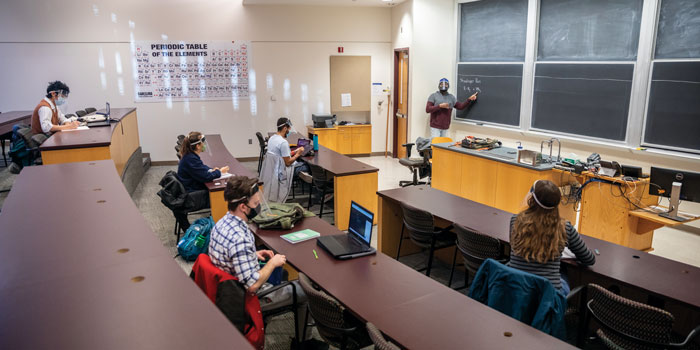
Advanced organic chemistry, taught in Noyce Science Center by Assistant Professor Erick Leggans ’05, was one of a small number of classes meeting in person on campus during fall term 2.
Going forward
Even as professors and students are finally becoming comfortable with the radical changes to teaching and learning mandated by the pandemic, their focus is shifting to their eventual return to campus. The digital leap that began as a necessity now serves as a glimpse into the future of education.
“Nothing will ever be as good as the in-person classroom,” says Garrison. “But learning to present online has been very beneficial and will be important.”
Among the lessons learned or confirmed to be true for faculty: It's not always necessary to be physically present in a lab to design experiments or analyze data. Simple content delivery is sometimes better served up as a recording that can be paused and re-watched as needed. Small group meetings to discuss readings or other content can be easier to facilitate online than in person and often inspire more meaningful participation. Virtual visits to museums, historic sites, galleries, and elsewhere provide learning opportunities that might not exist otherwise due to location or cost.
While Grinnell faculty plan to incorporate such online opportunities into their future classes, they say their in-person instruction will change, too.
“When we do get back in the lab, I wonder if there might be some benefit to making it more like a cooking show,” Sandquist says. “You put a cake in the oven and then, ‘Oh, look, here is one that’s already done.’ What learning did they miss by not waiting for 30 minutes for that thing to bake? Perhaps we could use that time recovered for other pedagogical benefit, such as discussing the theory of the lab technique.
“I realize that some of what I try to do in the lab can be repetitive or boring, as it is just waiting for something to happen. I want students to know that this is part of the process, but there has to be a sweet spot, and maybe that will force us to find where that sweet spot is.”
And getting to that “sweet spot” has always been the goal, whether learning takes place at home, in the lab, in the classroom, or in the field. “We are learning to not only adapt to the constraints we have been given, but to use them to our advantage,” Marshack says. “It’s been challenging, but absolutely worthwhile. It perfectly demonstrates Grinnell’s spirit of creativity and commitment to experiential learning and the liberal arts.”
A Student's Perspective
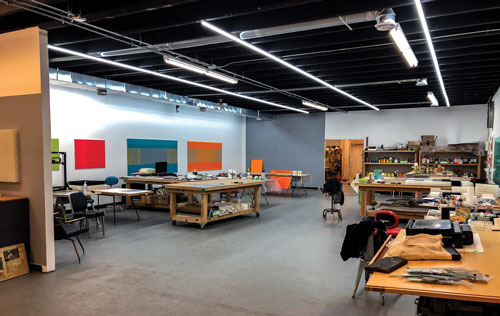 Noa Goldman ’22, a third-year French and English double major, is taking classes from her home in Chicago.
Noa Goldman ’22, a third-year French and English double major, is taking classes from her home in Chicago.
When she was sent home in the middle of the spring 2020 semester, her first concern was not how she would manage a shift to online classes, but how other aspects of her Grinnell experience would be affected.
“I think for me and a lot of students, we were thinking more about our friends and people graduating whom we wouldn’t see,” she says. “It was tough to adjust to the idea of leaving our friends.”
And while she hoped to be back on campus for the fall term, she was still at home, adjusting to the reality of remote learning and making the best of her situation.
“It’s been going really well,” she says. “I think students have been very flexible about the situation; and professors have, for the most part, been flexible as well. It’s hard not being around people day to day, but I’ve found it to be as good as it possibly can be.
“For the most part, the people I know and have talked to agree that the quality of their education hasn’t diminished in any crazy way,” she adds. “People are still busy and working very hard. The professors are really reaching out, and that’s something Grinnell has done well. I certainly learned as much last semester as I had in prior semesters.”
Note: Goldman is a reporter for The Scarlet & Black and has, along with others, written about the effect remote learning has had on classes. Read her excellent article on Matthew Kluber’s art class in the Fall 1 period.

